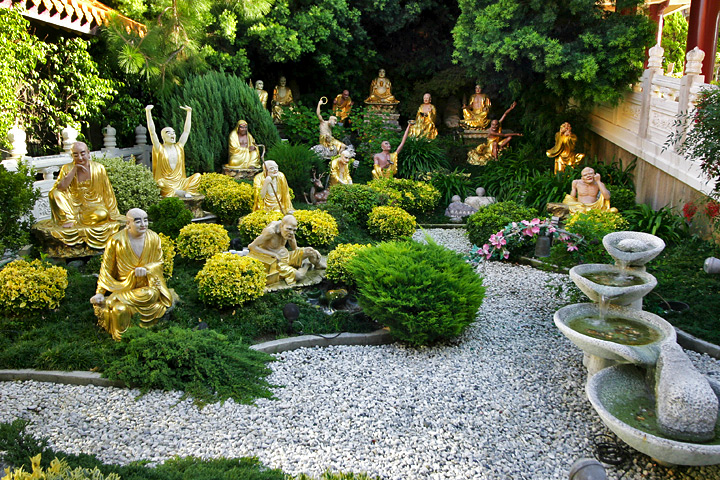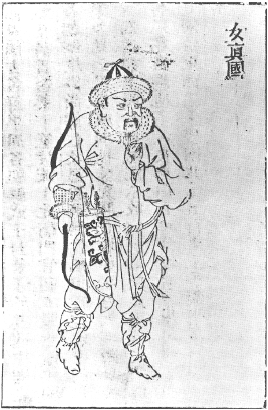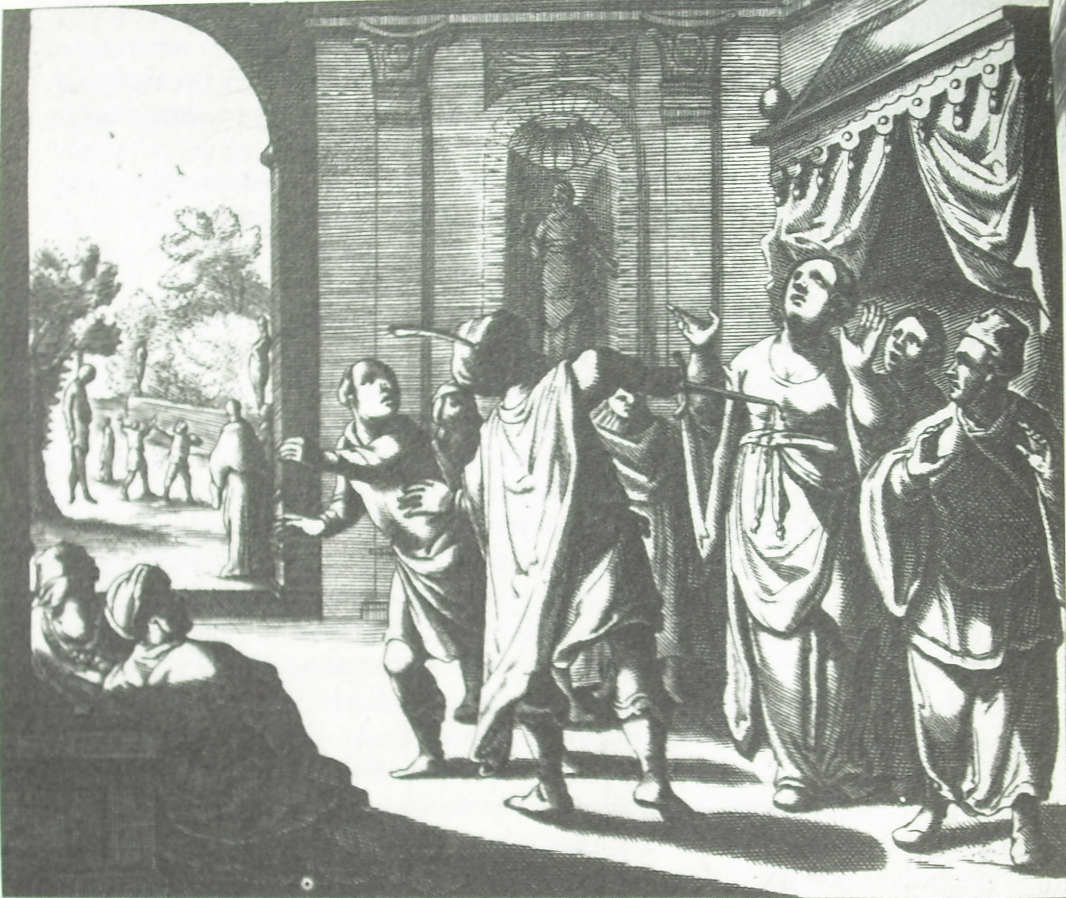|
Lushan Temple
Lushan Temple (), is a Buddhist temple at Yuelu Mountain, Changsha, Hunan, China. It includes the Entrance, Hall of Great Heroes, Zazen room, and dining room, etc. History Jin dynasty In 268, in the fourth year of the Taishi era of Emperor Wu of Jin, Zhu Fachong () built the Hui Guangming Temple (). It was the first temple in Hunan. After Zhu Fachong, the eminent monks Fadao () and Famin () served as Abbot. Sui dynasty In 589, in the ninth year of the Kaihuang era of Emperor Wen of Sui, Zhiyi () came to Hui Guangming Temple, explained the '' Lotus Sutra'' and taught Buddhism. In 602, he built a pagoda to preserve śarīra (relics) of the Buddha. Tang dynasty In the early Tang dynasty, the monk renamed it ''Lushan Temple'' (). Shenhui's disciple Mohe Yanna () came to Lushan Temple to advertise Folk Buddhism. In 845, after the Great Anti-Buddhist Persecution, Lushan Temple was broken down. In 847, in the first year of the age of Dazhong of Emperor Xuanzong, Jingcen () rebui ... [...More Info...] [...Related Items...] OR: [Wikipedia] [Google] [Baidu] |
Shanmen
The Gate of Shanmen or Hall of the Shanmen or simply Shanmen (), is the entrance gate of a Buddhist temple. In ancient times, nearly all Buddhist temples had a single Shanmen gate leading into a large hall for the temple. Today, it is observed that most of the surviving Chinese Buddhism, Chinese Buddhist temples follow the hall style but have three main gates incorporated into their construction. After successive wars and cultural discontinuity, most Chan Buddhism, Chan Buddhist temples have changed the middle gate into a hall entrance, called "Hall of Shanmen". The Shanmen is the most important gate of a Chan Buddhism, Chan Buddhist sect temple. Etymology One theory is that "''Shanmen''" takes its literal meaning of "Mountain Gate", because temples were traditionally built in forested mountain areas where Chan monks could seclude away from secular life. Another suggests that during various episodes of suppression of Buddhism in Chinese history, monks moved their monasteries deep ... [...More Info...] [...Related Items...] OR: [Wikipedia] [Google] [Baidu] |
Great Anti-Buddhist Persecution
The Huichang Persecution of Buddhism () was initiated by Emperor Wuzong (Li Chan) of the Tang dynasty during the Huichang era (841–845). Among its purposes was to appropriate war funds and to cleanse Tang China of foreign influences. As such, the persecution was directed not only towards Buddhism but also towards other religions, such as Zoroastrianism, Nestorian Christianity, and Manicheism. Rationale Emperor Wuzong's economic, social, and religious reasons for persecuting Buddhist organizations and temples throughout China were as follows: * ''Economic reasons'': In 843, the emperor's armies won a decisive battle against the Uyghur tribes at the cost of almost bankrupting the country. Wuzong's solution to the financial crisis was to go after the wealth that had been accumulated in the Buddhist monasteries. Buddhism had flourished greatly during the Tang period, and its monasteries enjoyed tax-exempt status. In 845, Wuzong closed many Buddhist shrines, confiscated their p ... [...More Info...] [...Related Items...] OR: [Wikipedia] [Google] [Baidu] |
Arhat
In Buddhism, an ''Arhat'' () or ''Arahant'' (, 𑀅𑀭𑀳𑀦𑁆𑀢𑁆) is one who has gained insight into the true nature of existence and has achieved ''Nirvana (Buddhism), Nirvana'' and has been liberated from the Rebirth (Buddhism), endless cycle of rebirth. The understanding of the concept has changed over the centuries, and varies between different schools of Buddhism and different regions. A range of views on the attainment of arhats existed in the early Buddhist schools. The Sarvastivada, Sarvāstivāda, Kāśyapīya, Mahāsāṃghika, Ekavyāvahārika, Lokottaravāda, Bahuśrutīya, Prajñaptivāda, and Caitika schools all regarded arhats as imperfect in their attainments compared to buddhahood, buddhas.Sree Padma. Barber, Anthony W. ''Buddhism in the Krishna River Valley of Andhra''. 2008. p. 44Warder, A.K. ''Indian Buddhism''. 2000. p. 277 Mahayana Buddhist teachings urge followers to take up the path of a bodhisattva, and to not fall back to the level of ... [...More Info...] [...Related Items...] OR: [Wikipedia] [Google] [Baidu] |
Cultural Revolution
The Cultural Revolution, formally known as the Great Proletarian Cultural Revolution, was a Social movement, sociopolitical movement in the China, People's Republic of China (PRC). It was launched by Mao Zedong in 1966 and lasted until his death in 1976. Its stated goal was to preserve Ideology of the Chinese Communist Party, Chinese socialism by purging remnants of Capitalism, capitalist and Four Olds, traditional elements from Chinese culture, Chinese society. In May 1966, with the help of the Cultural Revolution Group, Mao launched the Revolution and said that Bourgeoisie, bourgeois elements had infiltrated the government and society with the aim of restoring capitalism. Mao called on young people to Bombard the Headquarters, bombard the headquarters, and proclaimed that "to rebel is justified". Mass upheaval began in Beijing with Red August in 1966. Many young people, mainly students, responded by forming Cadre system of the Chinese Communist Party, cadres of Red Guards th ... [...More Info...] [...Related Items...] OR: [Wikipedia] [Google] [Baidu] |
Second Sino-Japanese War
The Second Sino-Japanese War was fought between the Republic of China (1912–1949), Republic of China and the Empire of Japan between 1937 and 1945, following a period of war localized to Manchuria that started in 1931. It is considered part of World War II, and often regarded as the beginning of World WarII in Asia. It was the largest Asian war in the 20th century and has been described as The Asian Holocaust, in reference to the scale of Japanese war crimes against Chinese civilians. It is known in China as the War of Resistance against Japanese Aggression. On 18 September 1931, the Japanese staged the Mukden incident, a false flag event fabricated to justify their Japanese invasion of Manchuria, invasion of Manchuria and establishment of the puppet state of Manchukuo. This is sometimes marked as the beginning of the war. From 1931 to 1937, China and Japan engaged in skirmishes, including January 28 incident, in Shanghai and in Northern China. Chinese Nationalist and C ... [...More Info...] [...Related Items...] OR: [Wikipedia] [Google] [Baidu] |
Republic Of China (1912-1949)
Taiwan, officially the Republic of China (ROC), is a country in East Asia. The main geography of Taiwan, island of Taiwan, also known as ''Formosa'', lies between the East China Sea, East and South China Seas in the northwestern Pacific Ocean, with the China, People's Republic of China (PRC) to the northwest, Japan to the northeast, and the Philippines to the south. It has an area of , with mountain ranges dominating the eastern two-thirds and plains in the western third, where its Urbanization by country, highly urbanized population is concentrated. The combined Free area of the Republic of China, territories under ROC control consist of list of islands of Taiwan, 168 islands in total covering . The Taipei–Keelung metropolitan area, largest metropolitan area is formed by Taipei (the capital), New Taipei City, and Keelung. With around 23.9 million inhabitants, Taiwan is among the List of countries and dependencies by population density, most densely populated countries. Tai ... [...More Info...] [...Related Items...] OR: [Wikipedia] [Google] [Baidu] |
Shunzhi Emperor
The Shunzhi Emperor (15 March 1638 – 5 February 1661), also known by his temple name Emperor Shizu of Qing, personal name Fulin, was the second Emperor of China, emperor of the Qing dynasty, and the first Qing emperor to rule over China proper. Upon the death of his father Hong Taiji, a Deliberative Council of Princes and Ministers, committee of Manchu princes chose the 5-year-old Fulin as successor. The princes also appointed two co-regents: Dorgon, the 14th son of Nurhaci, and Jirgalang, one of Nurhaci's nephews, both of whom were members of the Qing imperial clan. In November 1644, the Shunzhi Emperor was enthroned as emperor of China in Beijing. From 1643 to 1650, political power lay mostly in the hands of the prince regent Dorgon. Under his leadership, the Qing conquered most of the territory of the fallen Ming dynasty, chased Southern Ming, Ming loyalist regimes deep into the southwestern provinces, and established the basis of Qing rule over China proper despite highl ... [...More Info...] [...Related Items...] OR: [Wikipedia] [Google] [Baidu] |
Chongzhen Emperor
The Chongzhen Emperor (6 February 1611 – 25 April 1644), personal name Zhu Youjian, courtesy name Deyue,Wang Yuan (王源),''Ju ye tang wen ji'' (《居業堂文集》), vol. 19. "聞之張景蔚親見烈皇帝神主題御諱字德約,行五,生於萬曆庚戌十二月二十四日寅時,崩於崇禎甲申三月十九日丑時。" was the 17th and last emperor of the Ming dynasty. He reigned from 1627 to 1644. " Chongzhen", the era name of his reign, means "honorable and auspicious." Zhu Youjian was son of the Taichang Emperor and younger brother of the Tianqi Emperor, whom he succeeded to the throne in 1627. He battled peasant rebellions and was not able to defend the northern frontier against the Manchu. When rebels under Li Zicheng reached the capital Beijing in 1644, he committed suicide, ending the Ming dynasty. The Manchu formed the succeeding Qing dynasty. In 1645, Zhu Yousong, who had proclaimed himself the Hongguang Emperor of the Southern Ming dynasty, gave ... [...More Info...] [...Related Items...] OR: [Wikipedia] [Google] [Baidu] |
Hanshan Deqing
Hanshan Deqing (, Wade Giles: Han-Shan Te-Ch’ing, "Crazy Mountain, Virtuous Clarity", c. 1546–1623), was a leading Buddhist monk and poet of the late Ming dynasty China.Buswell Jr.; Lopez Jr. (2013) ''The Princeton Dictionary of Buddhism'', p. 344. Princeton University Press.Hsu Sung-Peng (1979), p. 1. He was also posthumously named Hongjue Chanshi (弘覺禪師). Hanshan was known for studying and teaching Pure Land, Huayan and Chan Buddhism. He is known as one of the four great masters of the Wanli Era Ming Dynasty, along with Yunqi Zhuhong (1535–1613) and Zibo Zhenke (1543–1603) both of whom he knew personally. He also wrote their biographies after their deaths. Hanshan has remained an influential figure in Chinese Chan Buddhism down to the twentieth century. His works are widely printed and published in various editions. His teachings were most recently promoted by modern figures like Xuyun (1840?-1959) and his disciple Charles Luk (1898–1978). Life Ea ... [...More Info...] [...Related Items...] OR: [Wikipedia] [Google] [Baidu] |
Ming Dynasty
The Ming dynasty, officially the Great Ming, was an Dynasties of China, imperial dynasty of China that ruled from 1368 to 1644, following the collapse of the Mongol Empire, Mongol-led Yuan dynasty. The Ming was the last imperial dynasty of China ruled by the Han people, the majority ethnic group in China. Although the primary capital of Beijing fell in 1644 to a rebellion led by Li Zicheng (who established the short-lived Shun dynasty), numerous rump state, rump regimes ruled by remnants of the House of Zhu, Ming imperial family, collectively called the Southern Ming, survived until 1662. The Ming dynasty's founder, the Hongwu Emperor (1368–1398), attempted to create a society of self-sufficient rural communities ordered in a rigid, immobile system that would guarantee and support a permanent class of soldiers for his dynasty: the empire's standing army exceeded one million troops and the naval history of China, navy's dockyards in Nanjing were the largest in the world. H ... [...More Info...] [...Related Items...] OR: [Wikipedia] [Google] [Baidu] |
Wanli Emperor
The Wanli Emperor (4 September 1563 – 18 August 1620), also known by his temple name as the Emperor Shenzong of Ming, personal name Zhu Yijun, art name Yuzhai, was the 14th List of emperors of the Ming dynasty, emperor of the Ming dynasty, reigning from 1572 to 1620. He succeeded his father, the Longqing Emperor. His reign of 48 years was the longest among all the Ming dynasty emperors. The Wanli Emperor ascended the throne at the age of nine. During the first ten years of his reign, the young emperor was assisted and effectively led by Grand Secretary Zhang Juzheng, a skilled administrator. With the support of the emperor's mother, Empress Dowager Xiaoding, Lady Li, and the imperial eunuchs led by Feng Bao, the country experienced economic and military prosperity, reaching a level of power not seen since the early 15th century. The emperor held great respect and appreciation for Zhang Juzheng. However, as time passed, various factions within the government openly opposed Zhang, ... [...More Info...] [...Related Items...] OR: [Wikipedia] [Google] [Baidu] |
Chenghua Emperor
The Chenghua Emperor (9 December 1447 – 9 September 1487), also known by his temple name as the Emperor Xianzong of Ming, personal name Zhu Jianshen, changed to Zhu Jianru in 1457, was the ninth emperor of the Ming dynasty, reigning from 1464 to 1487. He succeeded his father, Emperor Yingzong. Zhu Jianshen was born in 1447 as the son of Emperor Yingzong. When he was only two years old, his father was captured by the Mongols during the Battle of Tumu Fortress, and his uncle ascended the throne as the Jingtai Emperor. During this time, Zhu Jianshen was appointed as crown prince, but later his uncle removed him from the position. Zhu Jianshen was not restored as crown prince until 1457, when Emperor Yingzong overthrew the ill Jingtai Emperor in a coup and reascended the throne. The Chenghua Emperor began his reign at the age of sixteen. During the initial years of his reign, he implemented a new policy that included tax cuts and a focus on strengthening the state's power. Howe ... [...More Info...] [...Related Items...] OR: [Wikipedia] [Google] [Baidu] |








